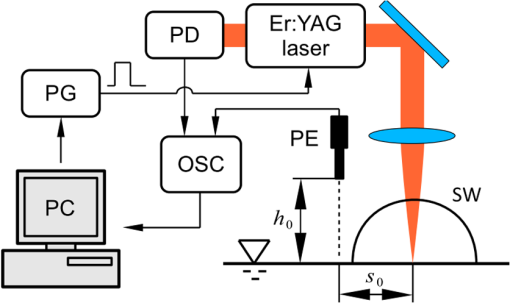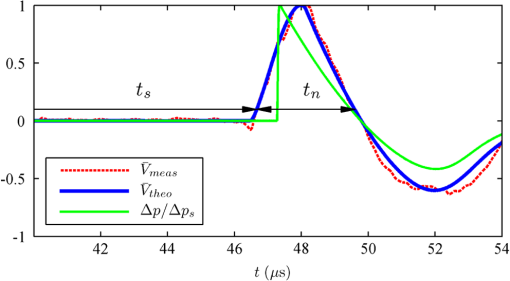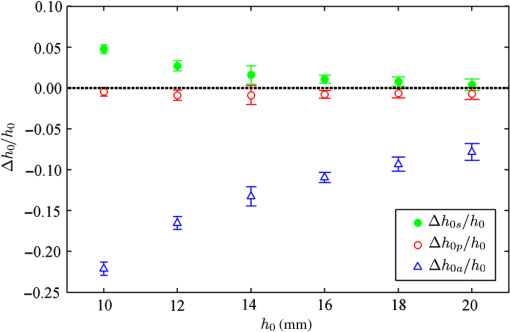|
|
|
Characterization of air propagating shock waves, resulting from the microexplosions generated during infrared laser ablation of biological tissues, is an optodynamic (OD) technique that has the potential to be used for on-line monitoring of ablative medical and surgical laser treatments.1 Compact and affordable broadband piezoelectric (PE) acoustic transducers that could be integrated into current medical laser systems have the potential to make OD ablation process monitoring practicable. The PE detection could be used for on-line tissue topography measurement by means of ablation source localization, which in combination with modern Er:YAG laser guiding systems, could enable the creation of defined geometries2 that would open a way to new laser-assisted treatments, i.e., in bone surgery. In contrast to alternative techniques, such as optical coherence tomography3 or laser triangulation,4 no additional excitation or optical elements are needed by this method. Strgar and Možina5 have shown that measured times of flights of air propagating shock waves have nonlinear dependence on the depths of laser-drilled holes. They fitted an exponential function over the measured data which gave significantly better results than the linear, however, such empirical definition of shock trajectory has limited applicability in practice. Perhavec and Diaci6 used a spatially resolved shock detection technique in the case of Er:YAG laser ablation where a Sedov–Taylor point explosion model proved to be suitable in describing shock-wave propagation. Nonlinear trajectory is a function of released energy which can be estimated from the characteristics of pressure waveforms using the point explosion model: Stauter et al.7 used shock time of flight, however, Diaci and Možina8 noticed that time of positive pressure phase gives better results in comparison with time of flight, which has greater sensitivity to released shock energy and only slight sensitivity to the distance from the source. The known OD methods of energy estimation use the source-to-sensor distance as a parameter and thus they cannot be used to improve source localization. In this letter, we present a method that enables simultaneous estimation of the released shock energy and the distance between the OD source on the ablated surface and a PE detector from a single detected OD signal. The method takes into account a nonlinear propagation of the released OD waves as well as finite aperture and oblique orientation of the PE detector. We demonstrate that the method significantly improves the accuracy of estimating the distance between an OD source and the PE detector. The experimental system used for this experiment is shown on Fig. 1. A free running Er:YAG laser (Fidelis Plus III, Fotona, Slovenia, European Union) beam is focused onto a water surface (focal diameter 0.9 mm) that serves as a tissue phantom. The water surface forms a quasi-ideal half-space which facilitates comparison with the theoretical model. A pulse generator (PG) triggers the laser system that uses VSP9 flashlamp pumping and also sets the pumping pulse duration (45 μs). The resulting laser pulses are short (), which allows repeatable generation of a single shock wave per laser pulse, rather than several consecutive shock waves that are typical for longer pulses. Laser pulse energy is (measured by Nova II, Ophir). A PE sensor (CA-1135, Dynasen, Goleta, California) with a PZT-5A crystal disc and diameter of 1 mm is used to detect the OD wave in air above the irradiated water surface. The sensor is mounted on a linear micrometer stage that allows setting of the vertical distance relative to the ablation spot with 10 μm resolution. The horizontal distance () between the center of the sensor and the ablation spot is determined by the radius of a CNC machined sensor bracket that is centered to the optical path. The aperture of the sensor is aligned parallel to the water surface for the purpose of easier experimental validation. Fig. 1Experimental set-up: shock wave (SW), piezoelectric sensor (PE), personal computer (PC), pulse generator (PG), photodiode (PD), oscilloscope (OSC).  OD signals are measured at six different vertical distances () with six repetitions carried out in each position. The digital oscilloscope (DSO6034A, Agilent, Santa Clara, California) used for signal acquisition (12-bit digitization, 10-ns sampling time) is triggered by the signal of an InAs photodiode (J12, Teledyne, Montgomeryville, Pennsylvania) which is mounted behind the back laser mirror. Measurements are collected on a personal computer (PC) where signal characteristics and , as shown in Fig. 2, are extracted from each measured signal waveform. They are defined in a way that allows reliable measurement: , representing the time of flight and representing the duration of the compressive phase. Room temperature and pressure are measured using standard meteorological equipment: , . Fig. 2Two selected signal features and defined on 10% of the normalized amplitude, used for the estimation of the vertical distance and released shock energy .  Horizontal distance is considered as a known parameter in this experiment and vertical distance as the estimated one. Using the acoustic wave approximation and assuming an idealized point sensor, we estimate from , where represents the speed of sound that is calculated from using the ideal gas approximation. We define the relative estimation error where represents the reference vertical distance determined by using the micrometer stage. Figure 3 shows the relative estimation error of this approximation at six measured reference distances . It is evident from Fig. 3 that the estimated distance is systematically smaller than the reference one, which is clear evidence that the OD wavefront propagates with supersonic speed.Fig. 3Relative errors of estimated vertical distances : acoustic wave propagation model, point detector model (); spherical blast wave propagation model, point detector (); spherical blast wave propagation model, finite size detector model ().  In order to improve distance estimation, we employ the Sedov–Taylor point explosion model, which describes spherical blast wave propagation and allows calculation of the pressure waveform (and thus its characteristics) at some distance from the source, given the conditions of the undisturbed surrounding medium (defined by pressure and temperature ) and one parameter, the released energy : . It is important to note that we assume that the released energy of the hemispherical OD wave is half of the released energy of an equivalent spherical blast wave. Figure 2 shows an example of a pressure waveform calculated using the model. To obtain the pressure waveforms, the model is formulated in the Euler form and solved numerically using the second order WAF finite volume explicit method with an approximate HLLC Riemann solver.10 Assuming an idealized point sensor, we take that the measured signals are proportional to the calculated pressure waveforms: Pressure waveforms are then used to determine two functions that describe the dependence of the characteristics and on the height and shock energy . The waveform characteristics and are determined using the definition given above with the measured signals. The two functions determined in a discrete form are numerically inverted to obtain the dependence of the height and shock energy on the pressure waveform characteristics and : We use the above functions to estimate the parameters and from the characteristics and , obtained by the analysis of the detected OD signals. The relative estimation error of this approximation, defined in a similar way as in the case of acoustic approximation, is shown in Fig. 3. We notice that this approximation significantly improves estimation accuracy by taking into account the nonlinear wavefront propagation, however, there are still some systematic errors present: estimates are systematically larger than the reference values . Another manifestation of the systematic errors present in this approximation is evident in Fig. 4, where we show the estimated released energy versus the reference distance . We observe that this approximation predicts a systematic decrease of the estimated released energies versus the reference distance which is in clear contradiction to what we expect in this particular experimental situation. Since we have reasonably constant excitation laser pulse energy, stable experimental conditions, and stable irradiated matter (water), it is reasonable to expect that the released OD wave energy is relatively stable. It might exhibit some statistical fluctuations but no systematic dependency on the distance . Fig. 4Estimated released shock energy versus vertical distance : point detector model () and finite size detector model ().  The observed systematic errors in this approximation can be explained by taking into account the finite aperture of the employed PE sensor. It takes some time for the shock wavefront to pass the complete sensor aperture and this accounts for some averaging effect in the response of a real sensor to shock-wave excitation. For this reason, the effect of a finite sensor aperture, and consequently the errors, is larger at lower vertical sensor positions . To further improve the distance estimation, we use a model of a PE sensor of finite aperture in conjunction with the point explosion model. We describe the employed sensor model in detail elsewhere.11 Here we present just a short outline. We treat the sensor as a one-dimensional element where current generating deformations occur only in its axial direction. With the assumption of pure elastic deformations, a transfer function for a force sensing element is obtained12 and validated by measuring electrical impedance on an impedance analyzer. Based on the analysis of the acquired waveforms and the transfer function for the given resistive load of the recording device (1 MΩ) and the total capacitance, the measured voltage is considered as proportional to the force of axial excitation. Neglecting the effects of changed acoustic impedance (weak incident shocks), we assume that the sensor response is proportional to the pressure distribution over the sensor aperture: Employing linear spherical wave propagation theory, we express the above integral as a convolution of the pressure transient at a point in the center of the aperture with the impulse response of the finite sensor aperture in a way described by Jensen.13 As in the case of an idealized point sensor, we then extract characteristics and from the normalized waveforms, determine the corresponding functions and for this particular approximation, and use them to estimate the parameters and from the measured signal characteristics and . Results on Fig. 3 show that the systematic part of the relative estimation error is thus significantly reduced in comparison with the point sensor model. The estimated released energy exhibits no systematic dependency on the distance (Fig. 4). A good agreement is observed by comparing the theoretical and measured waveforms. An example is shown in Fig. 2. In conclusion, the presented method employs PE detection and allows determination of the distance to the OD source and the released energy from each detected OD signal. The results demonstrate that the presented method allows single-shot measurements of the distance between an OD source and the PE detector with relative error of about 1%. This opens the possibility for on-line monitoring of Er:YAG laser ablation of tissue in quasi half-space for the purpose of creating defined geometries in a way similar to the approaches reported using other lasers and materials5,7 but with an improved accuracy and a measurement set-up which is more suitable to practical implementation. The released energy, on the other hand, can be a valuable process characteristic that does not depend on the position and the characteristics of the employed detection system in contrast to, e.g., the OD signal amplitude, which has been employed so far1,14 in characterization of laser ablation processes. ReferencesK. NahenA. Vogel,
“Investigations on acoustic on-line monitoring of IR laser ablation of burned skin,”
Lasers Surg. Med., 25
(1), 69
–78
(1999). http://dx.doi.org/10.1002/(ISSN)1096-9101 LSMEDI 0196-8092 Google Scholar
S. Stoppet al.,
“A new approach for creating defined geometries by navigated laser ablation based on volumetric 3-D data,”
IEEE Trans. Biomed. Eng., 55
(7), 1872
–1880
(2008). http://dx.doi.org/10.1109/TBME.2008.919737 IEBEAX 0018-9294 Google Scholar
A. Fuchset al.,
“Online measurement and evaluation of the Er:YAG laser ablation process using an integrated OCT system,”
Biomed. Tech., 57
(Sl-1), 434
–437
(2012). http://dx.doi.org/10.1515/bmt-2012-4231 BMZTA7 0013-5585 Google Scholar
D. QuestC. GayerP. Hering,
“Depth measurements of drilled holes in bone by laser triangulation for the field of oral implantology,”
J. Appl. Phys., 111
(1), 013106
(2012). http://dx.doi.org/10.1063/1.3676219 JAPIAU 0021-8979 Google Scholar
S. StrgarJ. Možina,
“An optodynamic determination of the depth of laser-drilled holes by the simultaneous detection of ultrasonic waves in the air and in the workpiece,”
Ultrasonics, 40
(1–8), 791
–795
(2002). http://dx.doi.org/10.1016/S0041-624X(02)00211-1 ULTRA3 0041-624X Google Scholar
T. PerhavecJ. Diaci,
“A novel double-exposure shadowgraph method for observation of optodynamic shock waves using fiber-optic illumination,”
J. Mech. Eng., 56
(7–8), 477
–482
(2010). Google Scholar
C. Stauteret al.,
“Laser ablation acoustical monitoring,”
Appl. Surf. Sci., 109–110 174
–178
(1997). http://dx.doi.org/10.1016/S0169-4332(96)00655-1 ASUSEE 0169-4332 Google Scholar
J. DiaciJ. Mozina,
“A study of energy conversion during Nd:YAG laser ablation of metal surfaces in air by means of a laser beam deflection probe,”
J. Phys. IV France, 04
(C7), 737
–740
(1994). Google Scholar
K. NemešM. LukačJ. Možina,
“Variable square pulse vs conventional PFN pumping of Er:YAG laser,”
Opt. Laser Technol., 44
(3), 664
–668
(2012). http://dx.doi.org/10.1016/j.optlastec.2011.09.020 OLTCAS 0030-3992 Google Scholar
E. F. Toro, Riemann Solvers and Numerical Methods for Fluid Dynamics: A Practical Introduction, Springer, Berlin Heidelberg, Germany
(2009). Google Scholar
G. BosigerT. PerhavecJ. Diaci,
“A method for optodynamic characterization of Erbium laser ablation using piezoelectric detection,”
J. Mech. Eng., http://dx.doi.org/10.5545/sv-jme.2013.1077 Google Scholar
J. P. Bentley, Principles of Measurement Systems, 4th ed.Pearson Education, Harlow, England
(2005). Google Scholar
J. A. Jensen,
“A new calculation procedure for spatial impulse responses in ultrasound,”
J. Acoust. Soc. Am., 105
(6), 3266
–3274
(1999). http://dx.doi.org/10.1121/1.424654 JASMAN 0001-4966 Google Scholar
R. Petkovšeket al.,
“Optodynamic monitoring of laser micro-drilling of glass by using a laser probe,”
Appl. Phys. A, 93
(1), 141
–145
(2008). http://dx.doi.org/10.1007/s00339-008-4658-0 APAMFC 0947-8396 Google Scholar
|

